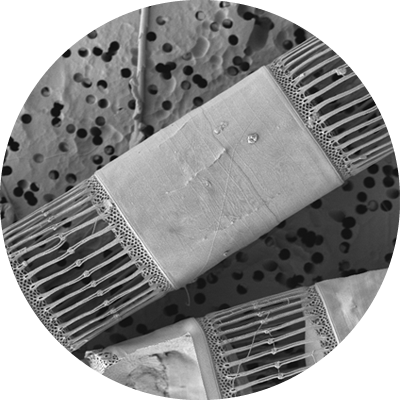
The chain-forming marine centric diatom Skeletonema marinoi Sarno & Zingone was described in 2005, as one of four new species identified in the Skeletonema costatum complex (Sarno et al., 2005). In the Baltic Sea, S. marinoi is the dominating species from this genus (Sjöqvist et al., 2015) and several studies from this area have focused on its ecology and evolution (see e.g. Godhe and Härnström, 2010; Härnström et al., 2011; Sefbom et al., 2018). The genome of S. marinoi strain R05AC has been sequenced and assembled into 81 primary contigs using the FALCON assembler (NG50 = 1.2 Mbp, estimated genome size 55 Mbp) and subsequently corrected using Illumina data. Genome annotation has identified 17203 genes (Johansson et al., 2019a).The genomes of ten bacteria from the S. marinoi microbiome have also been sequenced, in an effort to better understand the interactions within the diatom-bacteria holobiont (Johansson et al., 2019b, and references therein).
In addition to this, several molecular techniques have been developed for the species, making it a useful model for studies of ancient DNA, population genomics, selection and adaptation in diatoms. A method for genetic transformation, involving mutagenesis by random insertion of a construct by electroporation, has resulted in the establishment of a mutant collection for S. marinoi (Johansson et al., 2019a).
The R05AC strain, which the reference sequence originates from and which the mutant library is based on, was revived from a resting cell collected from surface sediment in Öresund, Sweden, in 2010 (Härnström et al., 2011). R05AC is available from the algal bank at University of Gothenburg (GUMACC).
A brief description of S. marinoi projects being worked on in the group can be found here.
Godhe A, Härnström K (2010) Linking the planktonic and benthic habitat: genetic structure of the marine diatom Skeletonema marinoi. Mol Ecol 19:4478–4490. doi: 10.1111/j.1365-294X.2010.04841.x
Härnström K, Ellegaard M, Andersen TJ, Godhe A (2011) Hundred years of genetic structure in a sediment revived diatom population. Proc Natl Acad Sci U S A 108:4252–4257. doi: 10.1073/pnas.1013528108
Johansson ON, Töpel M, Pinder MIM, Kourtchenko O, Blomberg A, Godhe A, Clarke AK (2019a) Skeletonema marinoi as a new genetic model for marine chain-forming diatoms. Sci Rep 9:5391. doi: 10.1038/s41598-019-41085-5
Johansson ON, Pinder MIM, Ohlsson F, Egardt J, Töpel M, Clarke AK (2019b) Friends With Benefits: Exploring the Phycosphere of the Marine Diatom Skeletonema marinoi. Front Microbiol 10:1828. doi: 10.3389/fmicb.2019.01828
Sarno D, Kooistra WHCF, Medlin LK, Percopo I, Zingone A (2005) Diversity in the genus Skeletonema (Bacillariophyceae). II. An assessment of the taxonomy of S. costatum-like species with the description of four new species. J Phycol 41:151–176. doi: 10.1111/j.1529-8817.2005.04067.x
Sefbom J, Kremp A, Rengefors K, Jonsson PR, Sjöqvist C, Godhe A (2018) A planktonic diatom displays genetic structure over small spatial scales. Environ Microbiol. 2018 Aug;20(8):2783-2795. doi: 10.1111/1462-2920.14117
Sjöqvist C, Godhe A, Jonsson PR, Sundqvist L, Kremp A (2015) Local adaptation and oceanographic connectivity patterns explain genetic differentiation of a marine diatom across the North Sea-Baltic Sea salinity gradient. Mol Ecol 24:2871–2885. doi: 10.1111/mec.13208